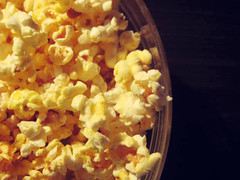I just finished reading an article about our country's economic woes. We aren't in an official recession yet, but it looks like one is coming. Prices are already rising. That really hit home with me a few weeks ago when the Friday night pizza delivery guy wanted $3 more for our pizza than he had the week before. That was about a 33% increase. Yikes.
Many aspects of going green will save you money, but there are areas where it costs more to be green. For me, the biggest hit to my wallet when it comes to being green is at the grocery store. Organic and natural items cost more, and I've read lots of arguments that Americans are going to have to accept that their food will cost more if they want food that is good for both the health of the environment and themselves. I can accept that. It costs more to produce organic and natural food.
But when the economy gets bad, I think that some people who understand that good food needs to cost more may revert back to buying a lot of processed, bad for them food because it costs less. When you've got a family to feed and the money is tight, it's tempting to buy what's on sale and you've got a coupon for, instead of buying fresh, whole foods.
I'm no expert on recession proofing your family, but I have been thinking about how to stretch my grocery dollars and still continue to feed my family healthy food if and when economic times get tougher. Here are some ideas that have been going through my mind:
Rethink your meat consumption
I am by no means a vegetarian, but I've been preparing meatless meals once in a while lately. I've also been consciously buying the amount of meat I need instead of wasting so much. For instance, we cook burgers at least once every two weeks. My boys like burgers, but never eat more than half of theirs each. It occurred to me that I only need to cook them one burger and split it in half. That way, I buy less meat and spend less money.
Use your leftovers wisely
How often do you throw leftovers away? I cringe when I clean out the frig and realize how much is getting thrown down the disposal. I've begun to have leftover night. I tell everyone what there is in the frig and let them choose what they want to eat. I often end up reheating several different dishes, but more leftovers are getting eaten. I'm also cooking one less new dish each week - that saves money.
If you aren't going to use leftovers before they go bad - freeze them. There have been many nights when my husband has been away that I've been able to defrost two small pieces of chicken or a small amount of taco meat for a meal for the boys and me. It's saved many a trip through the dreaded fast food window.
Buy from the bulk bins
I know not all grocery stores have them, but if yours does, check them out. I buy organic slow cooking oatmeal from the bulk bins for much less than if I bought it packaged on the shelf. Organic rice, lentils and other dry goods are less expensive there, too.
There are probably many other ideas about how to keep buying good food even if prices continue to rise, and I'll write more of them as I think of them. If you've got some ideas, please share them in the comments.
I have a feeling things are going to be economically tight for a while for us in the U.S. It would be a shame if just when the problems of the environment were just starting to really sink in to our national consciousness that our money problems caused us to revert back to some of our old ways. It's time to start thinking now of how we can continue to be green if the hard economic times hit, so we're prepared if it happens.

 I have to get to the local farm that allows you to pick your own strawberries. I don't know when I can get there, but my summer will be much sadder without my strawberries that I freeze for daiquiris.
I have to get to the local farm that allows you to pick your own strawberries. I don't know when I can get there, but my summer will be much sadder without my strawberries that I freeze for daiquiris.








